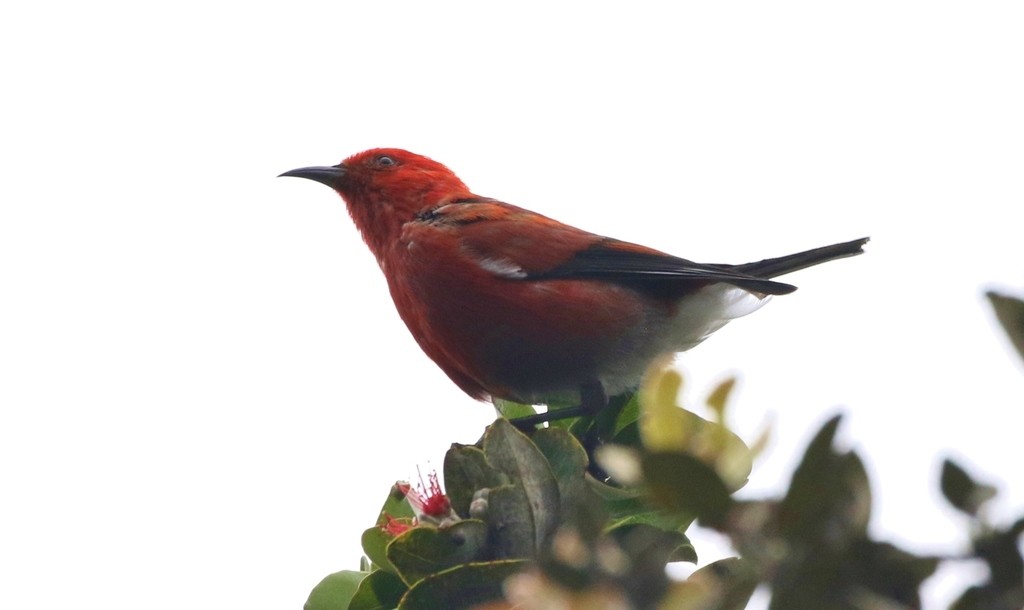Apapane
A species of Apapane and Laysan Honeycreeper Scientific name : Himatione sanguinea Genus : Apapane and Laysan Honeycreeper
Apapane, A species of Apapane and Laysan Honeycreeper
Botanical name: Himatione sanguinea
Genus: Apapane and Laysan Honeycreeper
Content
Description General Info
 Photo By silversea_starsong , used under CC-BY-NC-4.0 /Cropped and compressed from original
Photo By silversea_starsong , used under CC-BY-NC-4.0 /Cropped and compressed from original Description
ʻApapane are small at 13 cm (5.1 in) when fully grown. They are sexually dimorphic in size: male ʻapapane have a mass of 16 g (0.56 oz), while females average 14.4 g (0.51 oz). Adult ʻapapane are overall bright crimson, with distinct white undertail-coverts and lower abdomen feathers. They have black primaries and retricies. Juvenile ʻapapane are yellow-brown and gray, with the same white plumage as adults, and molt into crimson plumage over the course of two years. 'Apapane are often seen in a tail-up posture, showing off their white feathers. 
Size
13 cm (5 in)
Life Expectancy
11 years
Nest Placement
Tree
Feeding Habits
Apapane forages for nectar primarily from flowers, supplemented by foliage-dwelling insects and spiders, showcasing a diet adaptation for a varied nutrient intake.
Habitat
Apapane is primarily found in mesic and wet native forests, often at elevations above 1,250 meters where the climate restricts disease-carrying mosquitoes. These forests are typically dominated by ‘ōhi‘a, as well as koa, kōlea, naio, and tree ferns. Although apapane forages in higher-elevation, dry forests dominated by mamane, they rarely breed in these areas. The habitat receives an annual rainfall of 700–1,000 mm and is shared with other native and introduced bird species.
Dite type
Nectivorous
General Info
Feeding Habits
Bird food type
Distribution Area
ʻApapane are found in native mesic and wet forests dominated by ʻōhiʻa (Metrosideros polymorpha) and koa (Acacia koa) trees. Their range is extensive and their densities change as they undergo frequent temporal and seasonal migrations in search of flowering ʻōhiʻa. They are detected at low elevations on most islands, however, most ʻapapane are found at elevations above 4,100 feet (1,200 m), where there are fewer mosquitoes and therefore less disease pressure (See Threats and Conservation Section). 'Apapane live on the islands of Hawaiʻi (~86% of the population: 1,080,000 ± 25,000 est. 1986), Maui (228,480 ± 19,855 est. 2017 for East Maui and 20,521 ± 1,687 est. 2009 for West Maui ), Kauaʻi (98,506 est. 2012), Molokaʻi (38,643 ± 2,360 est. 1979), Oʻahu (24,000 ± 2,600 est. 1991), and Lānaʻi (540 ± 213 est. 1979). Their populations are stable and are considered a species of least concern by IUCN. 
Species Status
The main threats for 'apapane are habitat loss, disease and the introduction of alien species. ‘Apapane can be found on all of the main Hawaiian Islands except, Niihau and Kaho’olawe, where it is primarily found at high elevations where rates of avian malaria are comparatively low. The species is also threatened by non-native mammalian predators like Small Indian Mongooses (Herpestes javanicus), Rats (Rattus spp.), and feral cats (Felis catus). ‘Apapane are the most abundant honeycreeper species with the largest range. The total population has been estimated at more than 1.5 million individuals with the largest populations on Hawaii and Maui Islands. The species has the highest reported prevalence of avian malaria (Plasmodium relictum) but mortality is lower than most other honeycreeper species. This may be in part because seasonal migrations to lower elevation forest put it in contact with mosquitoes, which are less common at higher elevation. Malaria is a blood parasite, and death is usually cause by anemia, the loss of red blood cells. Like other honeycreepers, fowlpox (Poxvirus avium) may also be lethal to ʻapapane, which, like avian malaria, is transmitted by mosquitoes. Fowlpox causes wart-like lesions to form around the bird's eyes, beak, legs, or feet, inhibiting feeding, seeing, or perching. It is believed that at least a small portion of the population is becoming resistant to malaria, as some pairs have been seen breeding in mid-elevation forests, ~300m, where the rate of malaria transmission is high. Today there are no direct actions being taken concerning this species, however anything that is being done to help rarer species of birds throughout Hawaii will also help the ʻapapane. Organizations throughout the islands have established nature reserves to protect native habitat. Fencing off sections of land to keep out feral ungulates, especially pigs, goats and axis deer enables native plants to recover from overgrazing and ungulate damage and helps restore native bird habitat. In recent years another threat has put native bird habitat at risk. Conservation groups are diligently working to reduce the risk of spreading a disease called Rapid ʻŌhiʻa Death (ROD). This disease along with ʻōhiʻa dieback and ʻōhiʻa rust could lead to a rapid decline in ʻōhiʻa forests, an important nectar source for ʻapapane. 